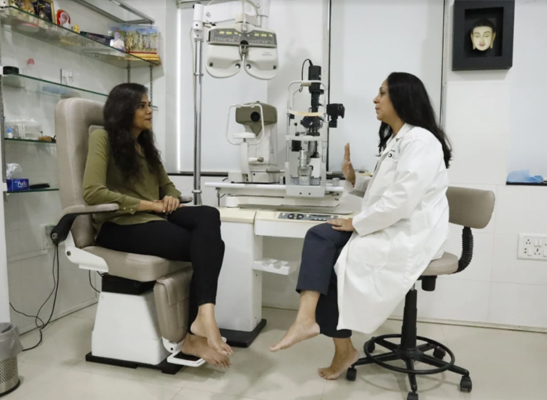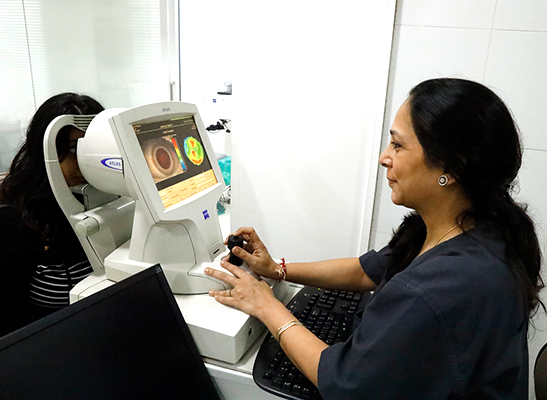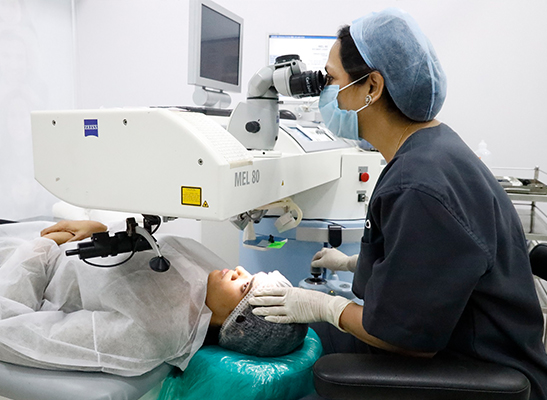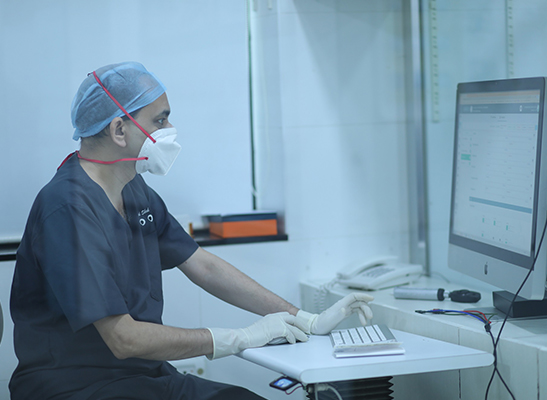The doctors at Samyak Drishti are great at what they do and use best-in-class technology. They have the knowledge, training and skills along with a rich experience of more than 25 years in vision correction and more than 50,000 surgeries.
Moreover, we are not limited by a single technology or procedure, and can offer a wide choice of procedures depending on your eyes.
Most importantly, they are straight forward and ethical. They do not hard sell anything. After a thorough examination, if you are found suitable, they will counsel you about your options. If you are found unsuitable, they will explain why and offer appropriate alternatives or deny any procedure, in the interests of your long-term safety.
"Amazing feeling to see the world clear vision without glasses. Thanks to Dr. Sujal Shah!" - PRIYANKA SHAH - LASIK Patient

GREAT VISION WITHOUT GLASSES, IN JUST MINUTES.
Approximately 700,000 LASIK procedures are performed in India every year. If you are considering LASIK to correct your vision, you owe yourself the very best.
Renowned LASIK Surgeon, Dr. Sujal Shah, founder of Samyak Drishti has been performing LASIK for more than 25 years. Dr. Manisha Shah has been performing LASIK for over 15 years. Since early in their careers they have remained at the forefront of development and research, always ensuring that their patients benefit from the latest and safest technological advances.
The result is that Dr. Sujal & Dr. Manisha have personally performed more than 50,000 vision correction procedures — and have been the LASIK surgeons of choice for doctors and their families, fellow surgeons, pilots, police, army, navy, athletes and celebrities
LASIK (Laser-Assisted in SItu Keratomileusis) is micro-surgery, performed by a surgeon with a laser, which reshapes the cornea, and thus changes the patient’s vision. It can correct the most common forms of vision impairment—myopia (nearsightedness), hyperopia (farsightedness) and astigmatism.
During LASIK eye surgery, a thin layer of tissue is folded back from the surface of the cornea. After the laser reshapes the cornea, the tissue is folded back into place, where it bonds quickly.
At Samyak Drishti, the entire procedure is performed using state-of-the-art surgical lasers, so there are no scalpels, stitches or needles. The time in surgery is 3 to 5 minutes per eye.
Healing for most patients is so fast that vision improves within hours of the procedure, and many patients return to work the next day.
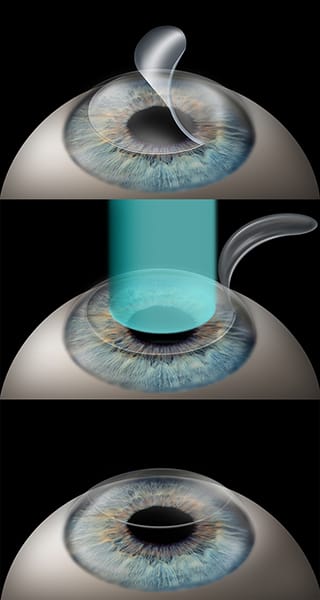
“The great thing about LASIK is my patients go back to normal life the next day. It’s what makes doing this so rewarding for me, because people come in with fear and leave happy.” Dr. Sujal Shah

Is LASIK Eye Surgery right for you?
Because your eyes and your vision are as unique as your fingerprints, it's very difficult for us to know whether LASIK eye surgery can benefit you without a personal examination. Recent medical advances have made it possible to correct problems that couldn't be corrected earlier. Dr. Sujal and Dr. Manisha deliver among the best LASIK has to offer.
In general, the conditions we are able to treat are near sightedness (myopia), far sightedness (hyperopia) and astigmatism. We like our patients to be at least 18 years of age, have healthy corneas, and to have had stable vision over the past year.
WHAT TO EXPECT DURING A LASIK CONSULTATION
Determining if you are a candidate for LASIK eye surgery is a multi-step process. We realize that making the decision to have LASIK comes only after careful consideration. During your consultation, Dr. Sujal or Dr. Manisha will evaluate your eyes and educate you about vision correction. This will enable you to make the best informed decision possible regarding your LASIK.
The first step is to go over your general medical history and evaluate the health of your eyes by measuring your vision. What really sets this evaluation apart is the multiparametric approach with the corneal mapping, corneal tomography, optical biometry, pupillometry and wavefront analysis.
Corneal mapping studies thousands of points on the cornea to generate a color-coded map of the corneal shape. It helps to plan Topography Guided LASIK or Corneal Wavefront Guided LASIK
Corneal tomography uses scheimpflug imaging technology to measure the front and back corneal surfaces, as well as other anterior segment structures to assess suitability for LASIK or other treatment options. Most importantly, it helps screen the eye for long-term safety after LASIK.
Ocular biometry uses a non-contact optical method to quickly analyse multiple parameters of the eye such as corneal shape and size, corneal thickness, pupil size, anterior chamber depth, length of the eyeball. This gives an overview of the ocular biometric measurements to help choose the right method for correction.
Pachymetry uses a special ultrasonic device to measure the thickness of the cornea to determine the extent of error that can be corrected safely
Wavefront analysis evaluates hundreds of different points on the eye. The result is a precise “map” of your vision that is significantly better than traditional measurements.
These scans enable Dr. Sujal or Dr. Manisha to determine your suitability and develop a customized plan for your eyes. After they review your results, they will guide you about your choices and the benefits and limitations of each.
Next, they will address any doubts or concerns you have and help you choose a procedure that is ideal for your eyes. We have one goal, giving you the best vision possible.
OUR LASER EYE SURGERY PROCEDURES
Advanced surface ablation
(ASA/PRK / EpiLASIK / TransPRK/Transepithelial PRK/LASEK)
This is a surgical alternative for patients who are not candidates for traditional LASIK eye surgery because of a thin cornea. With new technologies, the surgeons at SAMYAK DRISHTI can use laser eye surgery in Mumbai to restore vision in these cases as well.
Learn MoreFREQUENTLY ASKED LASIK QUESTIONS
Because we are perfectionists. And that reflects in our work. Simply good is not good enough. Before surgery, we personally check and refine your number, calibrate the laser and counsel you about what to expect. During surgery, we keep talking to you as we go along so that nothing comes as a surprise to you.
We are careful about who we recommend for surgery and what procedure we suggest. We explain the benefits and limitations and we won't hesitate to tell you if you are less than a good candidate
Our surgical plan is checked and double checked to ensure accuracy. We are not interested in simply doing a large volume of surgery, but in ensuring we do our best.
Great vision is all in the details and to get the best vision you need to get the best measurements.Through traditional ways of measuring,when your Dr says whether 1 or 2 is better, this is subjective and it measures only a single point on your eye. This type of measurement is good enough for getting your glasses or contacts made, but, may not be adequate for surgery.The way we measure the eye at Samyak Drishti is using multiple diagnostic sources which then gives us data regarding your eye and mapping every detail regarding the minute optical imperfections (Wavefront analysis) which can affect quality of vision.This data is then fed into the laser and your eye gets a customised treatment (Custom LASIK) according to it. This has the potential to give you the best possible vision often better than 20/20 in many patients.
Iris registration is capturing an image of the iris which is the coloured part of your eye and this is like mapping your fingerprint, because it is one of a kind. Iris registration surgery is a two step process. First the iris image is captured before surgery as a reference image. During surgery another image is acquired by the laser to optimise the rotational alignment of the eye prior to starting the laser for vision correction. If the eye is found to be misaligned, the treatment auto aligns to the eye to ensure accuracy. This is most relevant for treatments with high cylinder numbers and customized treatments.
Serious complications are possible with any surgery including LASIK. But, LASIK is extremely safe, I have never had any patient in my entire career who has lost vision to LASIK. In fact there is good evidence that LASIK is safer than wearing contact-lenses, as lenses carry the germs which you put into the eye every time you wear them, hence carrying a greater risk of losing vision due to lens related infections than LASIK.
The flap margins seal seamlessly with the rest of the cornea very quickly within hours of surgery. About 85% heals within a few days after surgery and about 99% by the end of the 1st year and pretty much 100 % after about 2 years. However, the flap is always there and can be lifted in the future, if needed for a re-treatment. Though, the flap does heal well, it is a covering and does not contribute to the biomechanical strength of the cornea.
The effects of LASIK are permanent. But, your eyes can change with age, you can develop cataracts with age or there can be a slight shift or slip in the vision due to multiple reasons. If that’s what is bothering you then we can fine tune it again so that you can get back the great vision you had right after the LASIK. If the slip in the vision is due to a cataract we need to do a cataract surgery. Either way our patients who have had LASIK can count on excellent long- term vision.
No, Monovision is one of the older ways to correct reading vision for people who wished to enjoy vision for distance and near without glasses. But since last 10 years for patients above the age of 40 who do not wish to wear glasses for near we have been doing Presbyond LASIK which is a superior way to correct reading vision. True to our mission to give you nothing but the best, we offer Presbyond LASIK to give you that seamless vision for distance, computer and up close without reaching for your glasses.
The LASIK procedure is generally very comfortable. The eye is numbed with anesthetic eye drops prior to the procedure. To allay the anxiety of pain we always instill an extra drop of the anaesthetic medication before going ahead with the surgery, but you may feel a slight pressure on the eye when the flap is being created. The procedure takes all of 5 minutes per eye. Typically, right after LASIK you can start seeing things around you (albeit a bit fuzzy), and that tends to be the most exciting moment for most patients who have LASIK
1st It may make your vision good but it may not be perfect, its still very good but could be a disappointment for you,and in that case we can definitely help you by doing a touch up procedure after 3 months of LASIK to refine your vision.
The 2nd common side effects of LASIK can be glare or halos, that means when you look at headlights/ streetlights you will notice a glow / halo around it and this could be an annoyance but generally settles down in a few weeks or months.
The 3rd most common issue after LASIK is you feel your eyes are a little drier than before, and this generally settles down in a few months. If it persists or bothers you, we will prescribe you medications or may advice you some procedure for it, for most people they feel much more comfortable after LASIK than they ever felt with contact lenses that little dryness is not a bother
Vision after LASIK is usually amazing, most people see better than they ever saw with their own glasses or contacts before surgery. But, if for some reason, if it is not good and can be perfected then we may recommend an enhancement or a touch up procedure after 3 months, where we apply a few more laser shots to improve your vision.
After LASIK we ask you to close your eyes for about 5 hours as that's when most of the healing in the flap occurs.
After a few hours you will be able to see around but it may not be too well or sharp, you will continue to use the eyedrops as advised and the next morning when you wake up,
that’s when you will feel the difference. You will be checked at the clinic on your first postoperative visit when we check your vision and review the medications.
You can resume all normal activities from the next day like going back to work or whatever pleases you except for touching, rubbing or splashing water in the eyes. Most people are in a position to drive with a couple of days after LASIK.
In LASIK we make a very precise flap on the outer skin of the eye called the cornea, we then fold it back and apply the laser shots which help in reshaping the cornea and this contributes towards a spectacle free vision. We then replace the flap, which heals back in a few hours.
In PRK we do not make the flap but apply the laser pulses straight to remove the outer layer of the cornea, followed by application of more along laser shots to correct your spectacle number, in this procedure we will as there is no flap the outer layer gradually heals back in 2 to 3 days, and eventually you get back the same results as LASIK but it only takes a little longer.
Schedule Your Consultation & Comprehensive Exam
Find out if you are a candidate from the Vision Correction Specialist.


 +917738273937
+917738273937